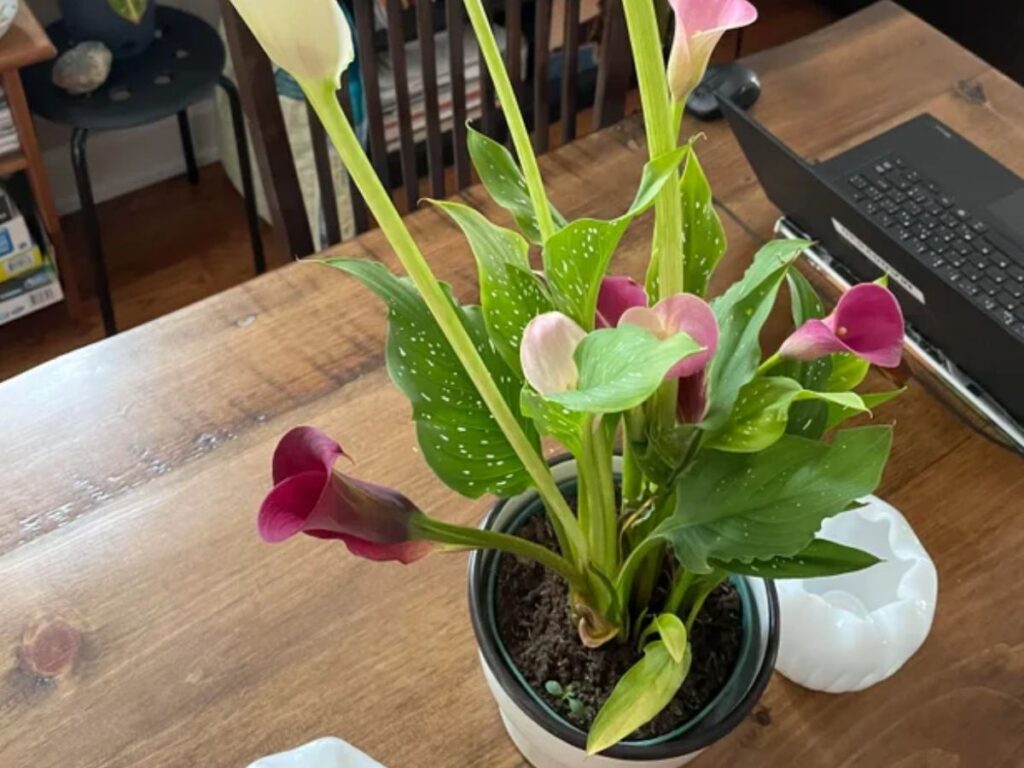Lilies are stunning and vibrant flowers that will instantly transform your garden. But if you have lilies that you want to transplant in the summertime, then it’s important to know exactly what you’re doing and plan ahead.
When it comes to answering the question of “can I transplant lilies in summer?”, fortunately the answer is yes – as long as you take into account a few key factors.
In this article, I’ll give some tips on how to properly transplant lilies, explain when the best time of year is for transplanting them, and provide some helpful advice for making sure your lilies thrive despite being moved.
Here’s the Answer: Can I Transplant Lilies in Summer?
You can transplant lilies in the summertime. However, take into account a few key factors: Ensure that the soil is moist, choose a location with plenty of sunlight and good drainage, dig up the lily bulbs carefully, replant them at the same depth, and water your transplanted lilies regularly.

Benefits of Transplanting Lilies in Summer
Transplanting lilies in the summertime can be a great way to give your garden an injection of colourful foliage. With the right care and attention, these hardy and resilient plants can really thrive and set off all your other flowers with their vibrant colours.
One major benefit of transplanting lilies during the summer months is that they need plenty of sun and warmth to grow – something they’ll get in abundance this time of year.
They also require damp soil conditions, which are perfect for July through September, so you’ll find your lilies establish strong roots quicker than if you wait until autumn or winter.
The summer’s ideal for mulching and fertilizing your lilies too – giving them the nutrients they need to stay healthy, look their best and be ready for bloom when the cooler weather comes around again.
In short, there’s plenty of reasons why transplanting lilies during the summer is a great idea!
Understanding the Requirements of Transplanting Lilies in Summer
If you want to transplant lilies in the summer, then it is important to understand the requirements for successful transplantation.
Firstly, you should look for a sunny spot with well-draining soil that has high fertility levels. Make sure that the soil is moist but not soggy.
Then create a hole twice as wide and twice as deep as the root ball of your lilies and place them inside before refilling with loose soil and lightly tamping down.
After transplanting your lilies, give them a good watering followed by mulching lightly to conserve moisture.
Steps for Transplanting Lilies in Summer
1. Selecting a Suitable Location for Transplanting
You’ll want to choose an area that gets at least six hours of direct sunlight each day; lilies need plenty of sun and water. If you’re using a container, make sure it is large enough to hold the roots of your lilies.
The soil type should also be considered for successful transplanting of lilies. Lilies prefer soils that are nutrient-rich but also well-draining; if you have clay or tightly packed soil, mix in some compost or peat moss to improve drainage.
Not only do you need to make sure your plants get enough sun and water in a suitable soil, you should also choose a spot away from any possible danger or disease. Be on the lookout for pests or animals that could harm the lilies as well as nearby plants affected by fungus or other illnesses.
By staying aware of these issues and plant worries, you can ensure the longevity and health of your beloved flowers!
2. Preparing the Soil for Transplanting
If you want your lily to successfully transplant and be healthy in its new location, then it helps to take the time to properly prepare the soil for transplanting.
First, a spade, trowel or ever a garden fork can be used to help loosen the soil in the area of transplantation – this will make it easier for the lilies roots to establish themselves.
Next you should mix in organic matter such as compost or aged manure into the area – these will add essential nutrients that your lilies need into the soil.
Finally, water the soil thoroughly and make sure that it is thoroughly moist before you start your transplanting process.
3. Digging Up and Removing the Lilies
You’ll need a spade or sharp garden fork to dig around and free the plant from the soil – just be sure to get the entire root system. Once it’s out, hold onto the root ball firmly while lifting it out of the ground. This will help ensure that the delicate roots stay intact during the move.
Once removed, place your lilies into a wheelbarrow or container for transport. For best success, remember not to break apart any of the roots as this can damage them considerably – they need to remain whole if they’re going to survive!
After transporting them, make sure to water regularly in order to keep things looking great up until transplant day!
4. Replanting the Lilies
First, carefully dig them up and remove them from their old home. Then, choose a new spot with well-draining soil and plenty of sunlight. Make sure you dig a hole with enough room for the entire root system.
Before replanting your lilies, give them a good soak in a bucket of water for about an hour–this will help them reestablish themselves in their new home.
Once they’ve soaked through, put them in the hole and backfill it with soil, making sure the crown of each lily is slightly above the soil line. Give them a good drink of water and add mulch around the base to keep moisture in.
Throughout the summer, be sure to keep your lilies alive by watering them deeply at least once week–at least one inch of water every week either from rainfall or from a hose. Don’t forget to check on their soil regularly to make sure it doesn’t dry out too much.
5. Watering and Caring for the Transplanted Lilies
Watering and caring for your transplanted lilies is key to helping them thrive. When you water, use a gentle stream aimed at the soil, avoiding splashing the leaves. This will ensure the soil stays moist but not soggy.
You should also apply a balanced fertilizer once a month during their growing season for extra nutrients.
In summer, lilies may be prone to sunburn, so it’s best to avoid transplanting them during this time.
If you do decide to move them, provide plenty of shade and mulch with compost or bark chips, which keep their roots cool and help protect from the sun’s rays.
Be sure to inspect your lilies regularly for pests or disease such as wilting or yellowing leaves. If they become infested with bugs, use a natural insecticide; if diseased, remove and dispose of affected plants immediately.
With proper care, your lilies will reward you with beautiful blooms year after year!
Common Transplantation Issues
When it comes to transplanting lilies during the summer, there are a few common issues you should be aware of.
Overwatering is one of the most frequent problems, since lilies cannot take too much water. To ensure your lilies are healthy and happy, you need to make sure you water them deeply, but then wait for the soil to dry between waterings.
Compaction is another issue that can arise when transplanting lilies. In order to avoid this problem, be sure to loosen the new soil in the area before actually transplanting your lilies – this will make sure their roots aren’t trapped in tight soil orders.
Finally, consider where you’re placing your transplanted lilies; they require plenty of sunlight (at least six hours per day), otherwise they may not survive in the new environment.
With all these tips under consideration, you can successfully transplant your summer lilies with minimum hassle!
Troubleshooting Transplantation Problems
Transplanting lilies in the summer can be tricky, so it’s important to be aware of potential issues and know how to troubleshoot them.
Ensuring that the soil is well-aerated with compost or mulch and that the lily is planted at its previous depth is key to preventing transplantation problems.
It’s also important to check the pH of your soil to make sure it suits the lily, as most prefer slightly acidic conditions. (The pH of your soil should be 6.0 to 6.5)
When you’re tending to your lily, keep an eye out for signs of pests and diseases like aphids or spider mites, and be mindful of how much water you give it—overwatering can cause root rot.
If you still find yourself encountering difficulties during the transplant process, consider adjusting your watering schedule, fertilizing, or applying organic pest control measures. With these tips in mind, you should have no problem getting your transplant back on track!
Frequently Asked Questions
How Often Should I Water Transplanted Lilies in Summer?
When transplanting lilies, it’s important to give them enough water so that their roots can establish in the new soil without drowning them. This means that you should water your transplanted lilies deeply but then wait until the soil has dried before watering again.
The frequency of watering depends on the climate and weather conditions – it could be every few days or once a week. You’ll need to keep an eye on things and adjust accordingly, making sure that your lilies have enough moisture to thrive without overwatering them.
What Kind of Soil Is Best for Transplanting Lilies?
The ideal soil for lily replantation is one that is rich in organic matter and well-drained. Compost or peat moss can be added to improve the structure and nutrition of the soil, while also helping to retain moisture.
Sandy soils are generally considered to be best for transplanting, as they are easier to dig and can hold moisture better than other types of soil. For clay soils though, it’s important to amend them with organic matter in order to improve their drainage.
If the soil is nutritionally deficient, then a slow-release fertilizer can also be used to give your lilies an extra boost when getting off the ground.
In conclusion, creating a rich and well-draining environment with compost or peat moss is essential when transplanting lilies – particularly if you’re dealing with sandy or clay soils. Adding a slow-release fertilizer will also help ensure your lilies have enough nutrients for optimal growth.
Is There a Specific Time of Year that Is Best for Transplanting Lilies?
While you can technically transplant lilies in summer months, the best times to transplant them are generally in the early spring or late fall. This is because the conditions tend to be cooler and more moist — two things that encourage root growth.
The exact time of year when you should transplant lilies will depend on your climate and the weather conditions in your area. For example, in colder climates you may want to transplant lilies earlier in spring while those living in warmer climates might want to wait until late fall.
Conclusion
Transplanting lilies in the summer can be a tricky task, but it is possible when done properly. It is important to consider the time of day and temperature when transplanting so as to not shock the plant. Additionally, it is important to be mindful of the soil type, water, and fertilizer needed for the lily to thrive in its new environment.
By following the steps outlined in this article, you can successfully transplant lilies in the summertime. With the right combination of soil, water, and fertilizer, you will give your lilies the best chance of survival. Take the time to research the best techniques for transplanting lilies and you will be rewarded with beautiful blooms for years to come.
Transplanting lilies in the summer can be done effectively with the right preparation. With the right amount of attention and care your lilies can thrive and add beauty to your garden for years to come.







